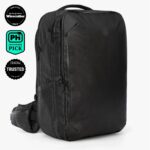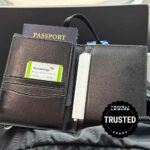Choosing the best wallet can make a big difference in your daily life. It’s not just about holding your cash and cards—it’s about style, convenience, and security.
But with so many options out there, how do you find the one that fits your needs perfectly? This guide will help you understand what to look for, so you can make a smart choice that feels right for you.
Keep reading, and by the end, you’ll know exactly how to pick the wallet that works best for your lifestyle.
Types Of Wallets
Choosing the right wallet depends on the type that fits your needs. Wallets come in different styles and designs. Each type offers unique features and benefits. Understanding these types helps you pick the best one for daily use or special occasions.
Bi-fold And Tri-fold
Bi-fold wallets fold once in the middle. They hold cash, cards, and IDs neatly. Tri-fold wallets fold twice, creating three sections. They offer extra space for more cards and cash. Both styles fit easily in pockets and bags.
Money Clips And Card Holders
Money clips keep cash tight and simple. They are slim and easy to carry. Card holders focus on carrying credit or ID cards. They are perfect for those who carry few items. These options reduce bulk and increase convenience.
Travel And Rfid Wallets
Travel wallets are larger and hold passports, tickets, and cash. They help keep travel documents safe and organized. RFID wallets block signals from stealing card information. They protect your data from electronic theft. Ideal for travelers and security-conscious users.
Minimalist Designs
Minimalist wallets have a slim, clean look. They carry only essentials like a few cards and some cash. These wallets fit comfortably in front pockets. They reduce weight and clutter while keeping things simple.
Materials And Durability
Choosing the right wallet means thinking about materials and durability first. The material decides how long the wallet lasts and how it looks over time. Some materials get better with age, while others need care to stay strong. Understanding different materials helps pick a wallet that fits your daily needs and style.
Leather Varieties
Leather is a classic wallet material. It feels soft and looks rich. Full-grain leather is the strongest type. It lasts many years and develops a unique shine. Top-grain leather is smooth but less tough. Genuine leather is cheaper but wears faster. Leather wallets breathe well and resist tearing with use.
Synthetic Options
Synthetic wallets use man-made materials like polyurethane or nylon. They often cost less than leather. These wallets resist water and stains easily. Many synthetic wallets feel light and flexible. They work well for active lifestyles or wet climates. Synthetic materials can mimic leather’s look too.
Metal And Fabric Choices
Metal wallets offer high durability and a modern look. Aluminum and stainless steel wallets protect cards well. They resist bending and water damage. Fabric wallets use canvas or nylon. They are soft, light, and often washable. Fabric wallets usually come in many colors and patterns.
Features To Consider
Choosing the right wallet means looking at several important features. These features help you find a wallet that fits your needs perfectly. Understanding these points makes your choice easier and smarter.
Capacity And Organization
Think about how many cards and cash you carry daily. A good wallet has enough slots for your cards, ID, and money. Some wallets have extra compartments for receipts or coins. Organizing your items well keeps everything easy to find. Avoid wallets that are too crowded or too empty.
Security Features
Protect your money and cards from theft. Some wallets have RFID blocking to stop electronic theft. Look for strong closures like zippers or snaps. Durable materials also add security. A secure wallet gives peace of mind wherever you go.
Size And Portability
Choose a wallet that fits comfortably in your pocket or bag. Large wallets hold more but can be bulky. Small wallets are easy to carry but may hold less. Balance size with your daily needs. A wallet that feels light and handy suits active lifestyles best.
Style And Personal Taste
Choosing a wallet is not only about function. Style and personal taste play a big role in your choice. Your wallet shows a bit of who you are. It should reflect your personality and daily needs. Pick a wallet that feels right for you.
Color And Design
Color sets the mood of your wallet. Classic black or brown works well for formal use. Bright colors or patterns add fun and uniqueness. Simple designs suit those who prefer minimalism. Look for a design that matches your vibe.
Brand And Price Range
Brands offer different styles and quality. Some brands focus on luxury and durability. Others provide affordable and trendy options. Decide on a budget before choosing a brand. Good quality doesn’t always mean high price.
Matching Your Lifestyle
Your wallet should fit your daily routine. A small, slim wallet works for those who carry little. Bigger wallets fit those who carry cards and cash. Consider your hobbies and work needs. Find a wallet that keeps up with your life.
Budgeting Your Purchase
Setting a budget helps you find the best wallet without overspending. It guides your choices and keeps your spending in check.
Knowing your budget helps you focus on wallets that fit your needs and price range. This way, you avoid wasting time on options you cannot afford.
Price Vs. Quality
Cheap wallets may look good but can wear out quickly. Expensive wallets often use better materials and last longer.
Consider how often you use the wallet. A higher price might be worth it for daily use.
Balance price and quality carefully. Choose a wallet that feels strong and fits your budget.
Long-term Investment
Think about how long the wallet will last. A durable wallet saves money over time.
Leather wallets can be more costly but age well with care. They often look better as they wear.
Spending a bit more on a good wallet means fewer replacements later.
Where To Buy
Buy wallets from trusted stores or official websites. This ensures you get the real product.
Check for return policies and warranties. These protect your purchase if the wallet has issues.
Compare prices at different places to find the best deal. Online and local stores both have options.
Care And Maintenance Tips
Taking good care of your wallet helps keep it looking new and lasting longer. Regular cleaning and proper storage prevent damage. Simple habits can protect your investment.
Follow these care and maintenance tips to keep your wallet in top shape. Small efforts lead to big results.
Cleaning Techniques
Use a soft cloth to wipe your wallet gently. Avoid harsh chemicals that can damage the material. For leather wallets, apply a small amount of leather cleaner. Let it dry naturally away from sunlight. For fabric wallets, spot clean with mild soap and water. Pat dry with a towel and air dry completely before use.
Storage Practices
Store your wallet in a cool, dry place. Avoid leaving it in direct sunlight or damp areas. Keep it away from sharp objects that might scratch or tear. Use a dust bag or soft pouch for extra protection. Do not overstuff the wallet, as this can cause it to lose shape.
Extending Wallet Lifespan
Rotate wallets to reduce wear and tear on one. Remove unnecessary cards and receipts regularly. Keep the wallet dry to prevent mold and odor. Handle your wallet with clean hands to avoid stains. Repair minor damages quickly to avoid bigger problems.
Frequently Asked Questions
What Materials Make The Best Wallets Durable And Stylish?
Leather and high-quality synthetic fabrics offer durability and a classic look that lasts long.
How Many Card Slots Should A Good Wallet Have?
Choose a wallet with 4 to 8 card slots to keep cards organized without bulk.
Which Wallet Size Fits Best In Pockets Comfortably?
Slim wallets that are about 4 inches wide fit most pockets without causing discomfort.
Are Rfid-blocking Wallets Necessary For Security?
RFID-blocking wallets protect your cards from digital theft in crowded or public places.
How To Pick A Wallet That Suits My Lifestyle?
Consider your daily needs: travel, work, or casual use to select the right wallet type.
Conclusion
Choosing the best wallet depends on your needs and style. Think about size, material, and how many cards you carry. A wallet should feel comfortable and suit your daily life. Pick one that lasts and matches your personality. Small details, like extra pockets, can make a big difference.
Take your time to find the right fit. A good wallet helps keep things organized and easy to find. Simple, practical choices work best for everyday use. Your perfect wallet is out there—just choose wisely.





